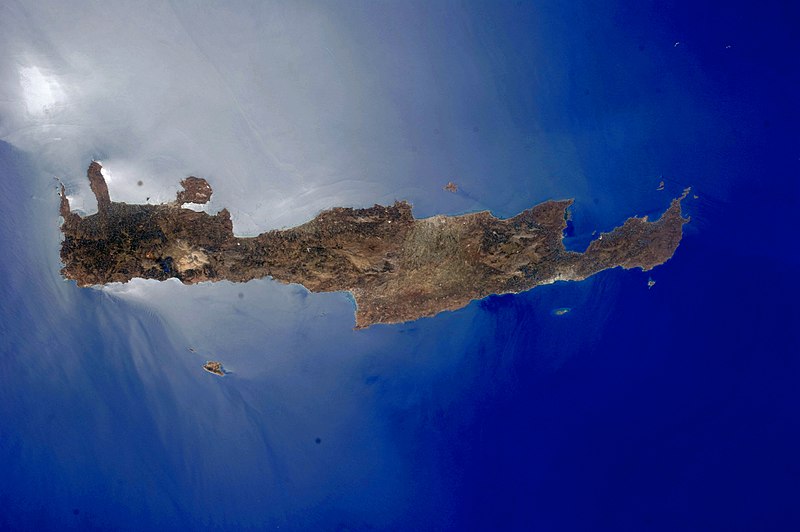File:Island of Crete, Greece.JPG

Original file (4,256 × 2,832 pixels, file size: 3.99 MB, MIME type: image/jpeg)
Captions
Captions
Summary
[edit]| DescriptionIsland of Crete, Greece.JPG |
English: The western and central parts of Crete appear surrounded by quicksilver in this astronaut photograph taken from the International Space Station. This phenomenon is known as sunglint, caused by light reflecting off of the sea surface directly toward the observer. The point of maximum reflectance is visible as a bright white region to the north-west of the island. Surface currents causing variations in the degree of reflectance are visible near the south-western shoreline of Crete and the smaller island of Gavdos (image lower left). |
| Date | |
| Source | NASA Earth Observatory |
| Author | ISS Expedition 28 crew |
This image or video was catalogued by Johnson Space Center of the United States National Aeronautics and Space Administration (NASA) under Photo ID: ISS028-E-18562. This tag does not indicate the copyright status of the attached work. A normal copyright tag is still required. See Commons:Licensing. Other languages:
العربية ∙ беларуская (тарашкевіца) ∙ български ∙ català ∙ čeština ∙ dansk ∙ Deutsch ∙ English ∙ español ∙ فارسی ∙ français ∙ galego ∙ magyar ∙ հայերեն ∙ Bahasa Indonesia ∙ italiano ∙ 日本語 ∙ македонски ∙ മലയാളം ∙ Nederlands ∙ polski ∙ português ∙ русский ∙ sicilianu ∙ slovenščina ∙ Türkçe ∙ українська ∙ 简体中文 ∙ 繁體中文 ∙ +/− |
Image acquired with a Nikon D3S digital camera using a 48 mm lens, and is provided by the ISS Crew Earth Observations experiment and Image Science & Analysis Laboratory, Johnson Space Center.
Licensing
[edit]| Public domainPublic domainfalsefalse |
| This file is in the public domain in the United States because it was solely created by NASA. NASA copyright policy states that "NASA material is not protected by copyright unless noted". (See Template:PD-USGov, NASA copyright policy page or JPL Image Use Policy.) |  | |
 |
Warnings:
|
| Annotations InfoField | This image is annotated: View the annotations at Commons |
sunglint
Dia
Heraklion
Gavdos
Mediterranean Sea
File history
Click on a date/time to view the file as it appeared at that time.
| Date/Time | Thumbnail | Dimensions | User | Comment | |
|---|---|---|---|---|---|
| current | 09:52, 15 August 2011 |  | 4,256 × 2,832 (3.99 MB) | Originalwana (talk | contribs) | {{Information |Description ={{en|1=The western and central parts of Crete appear surrounded by quicksilver in this astronaut photograph taken from the International Space Station. This phenomenon is known as sunglint, caused |
You cannot overwrite this file.
File usage on Commons
The following page uses this file:
File usage on other wikis
The following other wikis use this file:
- Usage on an.wikipedia.org
- Usage on ban.wikipedia.org
- Usage on bg.wikipedia.org
- Usage on bn.wikipedia.org
- Usage on br.wikipedia.org
- Usage on ca.wikipedia.org
- Usage on cs.wikipedia.org
- Usage on de.wikipedia.org
- Usage on el.wikipedia.org
- Usage on en.wikipedia.org
- Crete
- List of islands of Greece
- Portal:Greece
- Drapanias
- Geography of Greece
- Portal:Islands
- User:Chickstarr404/Gather lists/9320 – Mani by Leigh Patrick Fermor
- User:Northamerica1000/Topics
- Wikipedia:Featured picture candidates/February-2022
- Wikipedia:Featured picture candidates/Island of Crete, Greece
- Portal:Greece/sandbox
- Usage on en.wikivoyage.org
- Usage on fa.wikipedia.org
- Usage on got.wikipedia.org
- Usage on hy.wikipedia.org
- Usage on hyw.wikipedia.org
- Usage on id.wikipedia.org
- Usage on incubator.wikimedia.org
- Usage on it.wikipedia.org
- Usage on ja.wikipedia.org
- Usage on ka.wikipedia.org
- Usage on kk.wikipedia.org
- Usage on lfn.wikipedia.org
- Usage on ml.wikipedia.org
- Usage on nl.wikipedia.org
- Usage on no.wikipedia.org
- Usage on pl.wikipedia.org
- Usage on ps.wikipedia.org
- Usage on pt.wikipedia.org
- Usage on ru.wikipedia.org
- Usage on sl.wikipedia.org
- Usage on sq.wikipedia.org
View more global usage of this file.
Metadata
This file contains additional information such as Exif metadata which may have been added by the digital camera, scanner, or software program used to create or digitize it. If the file has been modified from its original state, some details such as the timestamp may not fully reflect those of the original file. The timestamp is only as accurate as the clock in the camera, and it may be completely wrong.
| Camera manufacturer | NIKON CORPORATION |
|---|---|
| Camera model | NIKON D3S |
| Exposure time | 1/500 sec (0.002) |
| F-number | f/10 |
| ISO speed rating | 200 |
| Date and time of data generation | 10:52, 22 July 2011 |
| Lens focal length | 48 mm |
| Orientation | Normal |
| Horizontal resolution | 240 dpi |
| Vertical resolution | 240 dpi |
| Software used | GIMP 2.6.8 |
| File change date and time | 10:15, 15 August 2011 |
| Exposure Program | Shutter priority |
| Exif version | 2.21 |
| Date and time of digitizing | 10:52, 22 July 2011 |
| APEX shutter speed | 8.965784 |
| APEX aperture | 6.643856 |
| APEX exposure bias | 0 |
| Maximum land aperture | 3 APEX (f/2.83) |
| Metering mode | Pattern |
| Light source | Unknown |
| Flash | Flash did not fire |
| DateTime subseconds | 73 |
| DateTimeOriginal subseconds | 73 |
| DateTimeDigitized subseconds | 73 |
| Color space | sRGB |
| Sensing method | One-chip color area sensor |
| Custom image processing | Normal process |
| Exposure mode | Auto exposure |
| White balance | Auto white balance |
| Digital zoom ratio | 1 |
| Focal length in 35 mm film | 48 mm |
| Scene capture type | Standard |
| Contrast | Normal |
| Saturation | Normal |
| Sharpness | Normal |
| Subject distance range | Unknown |